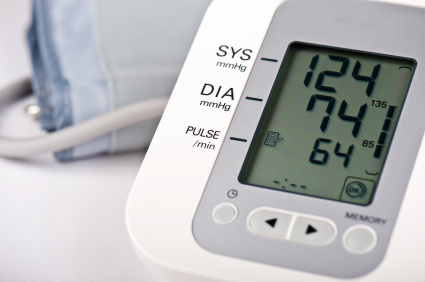When you get your blood pressure taken at the doctor’s, what do you see? Something like this?
In reality, probably not. When I think of blood pressure readings I imagine numbers on a display, but my actual experience of blood pressure measurement is different.
Not once, in all my years of visiting the doctor, have I seen the front of a blood pressure monitor in the surgery. It’s always positioned so that the doctor can see the numbers, but I can’t.
There may be a good reason for this. “White coat syndrome”, or iatrogenic blood pressure, is well documented. In other words, if the very act of testing by a doctor pushes your blood pressure up, hiding the numbers seems like a good way to reduce patient anxiety.
But does that really make sense? I can’t think of any stressful situation which can’t be made more stressful by the withholding of important information. Humans like to know what’s happening and how they’re doing. If we’re being tested, we like feedback. If you’re anxious about your blood pressure test and you can’t see the numbers, you’ll probably be watching the doctor’s face in an attempt to get at least some visual information.
It’s become accepted wisdom that we learn and remember best when given good visuals. So I think it’s all the more striking that doctors don’t position that monitor so we can see it. Instead, they usually tell us the numbers verbally, without explanation and without offering to write anything down. Yes, if you ask “Is that good or bad?” you’ll get an answer. But you usually do have to ask.
My own blood pressure has always been on the low side, which means I’ve never experienced the deeply unhelpful cycle of high blood pressure > medical comment > anxiety about high blood pressure > higher blood pressure. Instead, I’ve seen countless doctors looking at my reading, saying “Ooh, that’s low” and then cheerfully moving on to other matters. I’ve never had any context except the idea that low is good and high is bad.
In my early 20s I discovered the joys of internet-enabled valetudinarianism, and when I got back from a doctor's appointment I looked up my recent blood pressure reading online. That's when it dawned on me that the problems I'd been having with tiredness and dizziness might be connected to low blood pressure. (Later on, the disappearance of these problems coincided with my blood pressure going up into the “normal” range.) But the penny would never have dropped if I hadn't been lucky enough to get that day's blood pressure reading in round numbers, memorable enough to survive my walk home and the firing up of an early-Noughties internet connection.
I should make it clear, if it’s not clear already, that I have no medical training and no experience of working in an environment where blood pressure readings are taken. I can only write about my own experience as a patient, which may not be typical. But if it is typical – if other people share the experience of looking at the blank back of a blood pressure monitor – I want to ask why.
I think it’s because the NHS is not run with usability in mind, let alone user testing. If a GP hired just one tester, just one person to act as a dummy patient and go through the blood-pressure-testing experience, that user would immediately comment on the lack of visual information. And those comments would seem forehead-slappingly obvious in retrospect.
We’re hearing a lot at the moment about “increasing patient choice” through introducing markets into healthcare. But rather than seeing patients as rational consumers in a free market, I’d prefer to see them as service users in need of more user-friendly services.
The backwards-facing blood pressure monitor is just one tiny example of how we could improve the way people experience NHS services. It may seem like a petty thing to focus on, but it’s worth bearing in mind that angling that monitor differently would improve the patient experience without costing a penny or changing anything to do with the organisation of the health service. I wish the current debate about the NHS could be turned in another direction.
